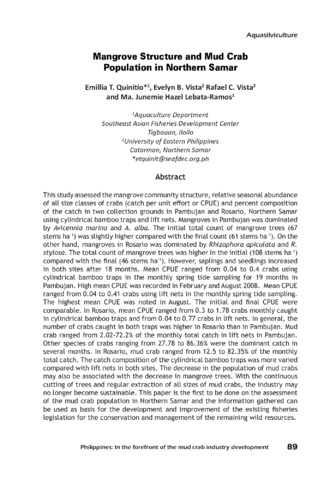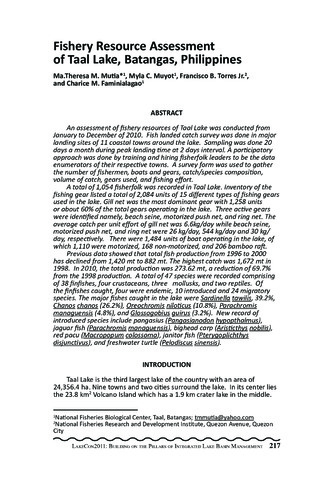Diversity and distribution of freshwater fish assemblages in Tayabas River, Quezon (Philippines)
| dc.contributor.author | Paller, Vachel Gay V. | |
| dc.contributor.author | Corpuz, Mark Nell C. | |
| dc.contributor.author | Ocampo, Pablo P. | |
| dc.date.accessioned | 2015-05-20T12:40:04Z | |
| dc.date.available | 2015-05-20T12:40:04Z | |
| dc.date.issued | 2013 | |
| dc.identifier.citation | Paller, V. G. V., Corpuz, M. N. C., & Ocampo, P. P. (2013). Diversity and distribution of freshwater fish assemblages in Tayabas River, Quezon (Philippines). Philippine Journal of Science, 142(1), 55-67. | en |
| dc.identifier.issn | 0031-7683 | |
| dc.identifier.uri | http://hdl.handle.net/10862/2236 | |
| dc.description.abstract | Three stream sections (upstream, midstream, and downstream) of Tayabas River, Philippines were surveyed during the wet and dry seasons of 2010 to evaluate the poorly known status of freshwater fish assemblages. The study collected a total of 1,070 individuals comprising 15 species, 13 genera, and 8 families. The three most abundant groups were poeciliids (61.85%), gobiids (26.16%), and cichlid (5.51%). Shannon-Weiner’s diversity indices ranged from 1.270 to 2.171. Relatively high Shannon evenness indices (0.653–0.846) and low Simpson’s dominance values (0.142–0.322) were calculated implying a fairly equitable distribution of niche space for dominant and non-dominant fishes. Significant change on fish assemblage in longitudinal gradient was observed (p<0.05), being the most diverse fish assemblage registered in the upstream. Species richness is mostly composed of native fish species (10 species) and mainly represented by stream gobiids (six species). The downstream, however, had the highest cumulative abundance, in which the larger proportion was from introduced species. Also, wet season had considerably more fish species and individuals relative to dry season (p<0.05). This significant spatio-temporal differences in fish assemblage data were evaluated by multivariate analyses (p<0.05). Canonical correspondence analysis identified the depth (seasonal water level fluctuations), vegetation growth, and dissolved oxygen concentrations (in order of importance) as the most influential environmental parameters affecting fish assemblage structure. Also, climatic stress (prolonged drought) and anthropogenically-induced habitat alteration could negatively affect the integrity of freshwater fishes within the river. The study suggests extensive management programs of the river for the protection of native fish species. | en |
| dc.language.iso | en | en |
| dc.publisher | Science and Technology Information Institute | en |
| dc.relation.uri | http://philjournalsci.dost.gov.ph/vol142no1/pdf/Diversity%20and%20Distribution%20of%20Freshwater%20Fish.pdf | |
| dc.subject | Diversity | |
| dc.subject | Fish assemblages | |
| dc.subject | Native and introduced fish species | |
| dc.subject | Philippines | en |
| dc.subject | vegetation | en |
| dc.title | Diversity and distribution of freshwater fish assemblages in Tayabas River, Quezon (Philippines) | en |
| dc.type | Article | en |
| dc.citation.volume | 142 | |
| dc.citation.issue | 1 | |
| dc.citation.spage | 55 | |
| dc.citation.epage | 67 | |
| dc.citation.journalTitle | Philippine Journal of Science | en |
| dc.subject.asfa | freshwater fishes | en |
| dc.subject.asfa | statistical analysis | en |
| dc.subject.asfa | climate change | en |
| dc.subject.asfa | dry season | en |
| dc.subject.asfa | species diversity | en |
| dc.subject.asfa | rainy season | en |
| dc.subject.asfa | species | en |
| dc.subject.asfa | rivers | en |
| dc.subject.asfa | seasons | en |
Files in this item
| Files | Size | Format | View |
|---|---|---|---|
|
There are no files associated with this item. |
|||
This item appears in the following Collection(s)
-
Journal Articles [1256]
These papers were contributed by Department staff to various national and international journals.




